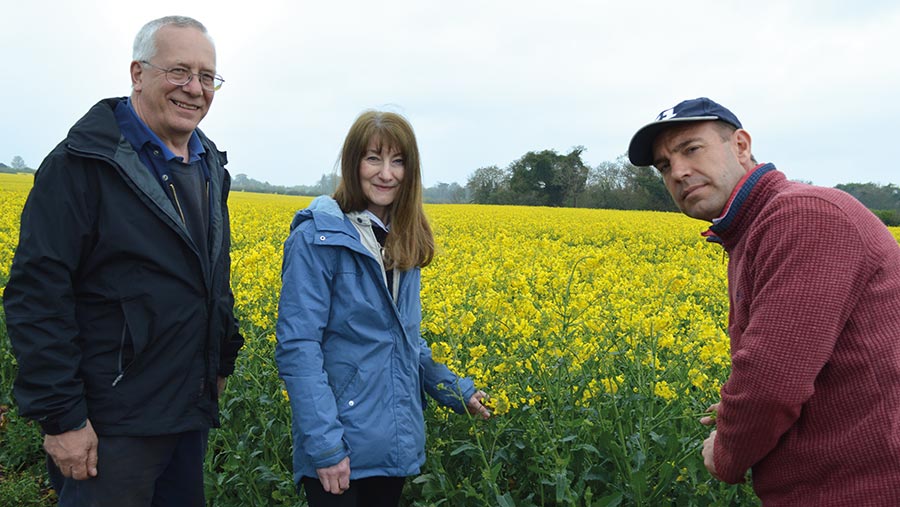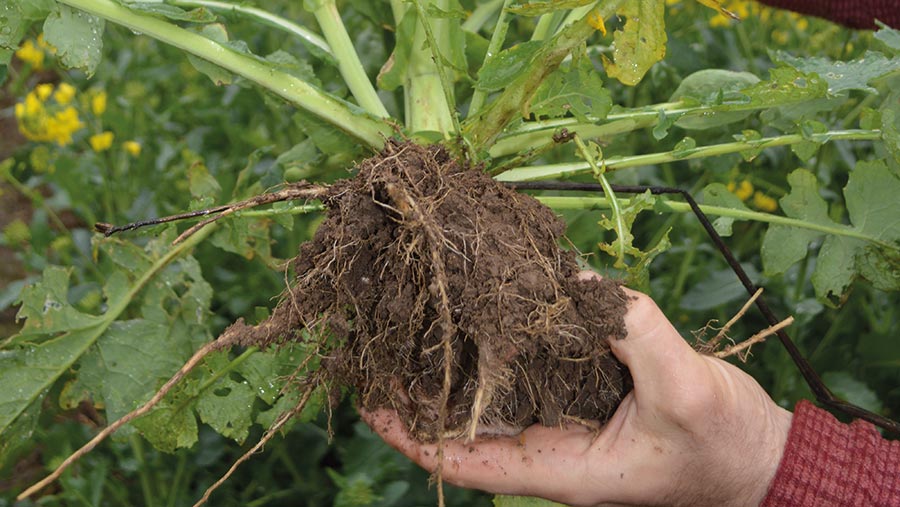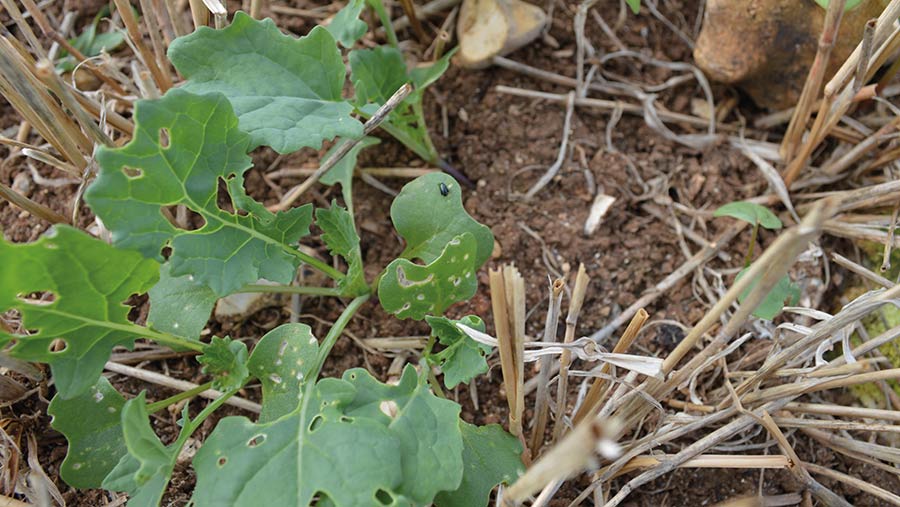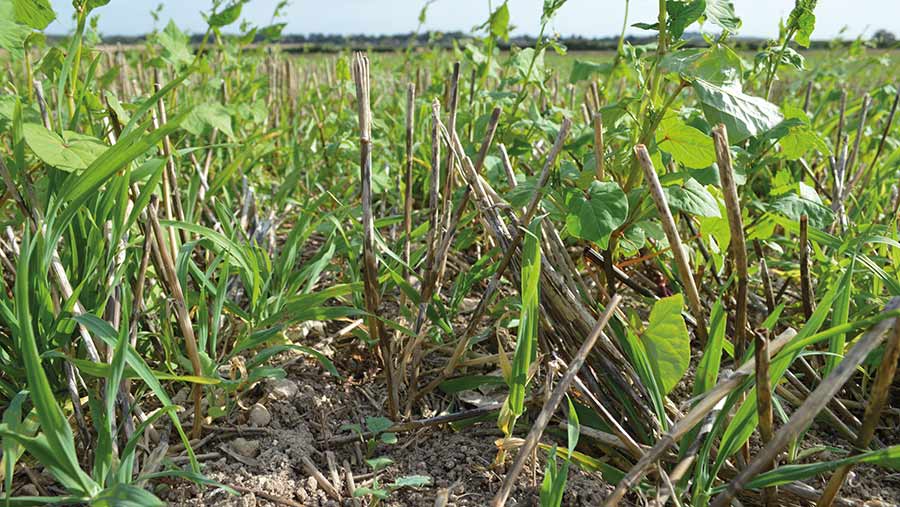OSR makes a comeback with new drill and companion crop
 Andrew and Ruth Spratt with John Vickery ©MAG/David Jones
Andrew and Ruth Spratt with John Vickery ©MAG/David Jones Andrew and Ruth Spratt are back growing oilseed rape after a four-year gap armed with a new drill and using companion crops on their Gloucestershire farm to ward off pest attacks, and with the chance of an environmental payment.
Their rapeseed crops for harvest in 2017 and 2018 were either written off or badly damaged by cabbage stem flea beetles, but their flowering crop now looks good for harvest 2023, and using a companion crop could qualify them for a £55/ha payout.
See also: Late drilling and companion crops works for Dorset OSR crop
Farm facts
Hazel Farm, Alveston, Bristol
- Home farm 186ha, plus contracted farm of 100ha
- Soils Heavy clay to sandy clay loams
- Cropping Winter wheat, oilseed rape and maize on home farm. Contracted farm also includes spring barley and spring linseed
The purchase of a low soil disturbance direct drill used to establish rapeseed in tall wheat stubbles, together with growing a buckwheat-purple vetch companion crop, have dramatically cut flea beetle larvae damage without any recourse to using foliar insecticides.
“This has given us more confidence in growing oilseed rape, and we are very pleased with the crop this season,” Mr Spratt tells Farmers Weekly.

© MAG/David Jones
Yield levels
He is hoping this year’s crop will match the 3.75t/ha yield achieved before flea beetles started attacking the farm’s output, following the banning of neonicotinoid insecticide seed treatment in December 2013.
The use of companion crops could qualify the farm to claim £55/ha under the Sustainable Farming Incentive (SFI), which is part of an environmental benefit package to replace the area-based Basic Payment Scheme (BPS).
The companion crop option announced earlier this year has attracted interest among oilseed rape growers, especially those already using the technique to establish crops successfully and deflect flea beetle attacks.
“We are going to have to apply for this companion crop option as BPS is dropped,” says Mrs Spratt.
Rapeseed return
The return to oilseed rape cropping on the 186ha Hazel Farm, Alveston, just north of Bristol, was helped by advice and guidance from John Vickery, regional technical adviser covering Gloucestershire and Worcestershire for agronomy firm Agrii.
The farm purchased an Amazone Cayena 6m tined low soil disturbance drill to give the farm better timeliness for drilling winter cereals, replacing a 3m Claydon drill which had helped the farm gradually move away from a plough-based system some 15 years ago.
The drill, primarily bought for winter cereals, was used to drill the first oilseed rape crop for four seasons on 19-20 August last summer across 52ha, as Mr Vickery looked to work out what went wrong with previous pest-damaged crops, and suggest pointers to avoid those problems in the future.
Factors for success
First, was to drill into a long 250mm winter wheat stubble to help disguise the young emerging rapeseed crop from marauding adult flea beetles, often attracted by bare brown soil, during their major migration period, usually around the August bank holiday.
Second, was the use of the low-disturbance drill which gave faster drilling and a more consolidated seed-bed than the 3m Claydon strip drill with fewer soil clods and less fuel used.
The drilled ground was immediately consolidated with a Cambridge roller to conserve soil moisture.
“The drill gave a tight and tidy seed-bed finish to stop the flea beetles crawling down the gaps in the soil and then attacking the young rapeseed plants,” says Mr Vickery.
Third, the buckwheat-vetch companion crop helped reduce the number of larvae in the crop due to the adults laying fewer eggs in the rapeseed, probably caused by the lower number of adults landing in the crop, and also by those adults that did land laying eggs near the companion crop plants rather than the rapeseed.

© MAG/David Jones
Spring damage
Larval damage is usually only really observed in the spring when a majority of the crop’s inputs in terms of seeds, herbicides, fungicides, slug pellets and fertilisers have been applied.
So, a substantial amount of investment in terms of inputs is largely wasted if the crop is written off.
In addition, when oilseed rape was dropped from the farm it was replaced by maize grown for silage in return for manure from a neighbouring dairy farm, and this manure has helped improve the fertility of the soils to get crops, including oilseed rape, off to a good start.
The farm’s rotation now consists of winter wheat with a break crop of oilseed rape or maize.
Mr Spratt was prepared not to drill oilseed rape if there was little soil moisture in the very dry summer of 2022, but local rainfall encouraged him to drill the 52ha of rapeseed in two days, which went in well and was followed by two weeks of dry weather.
The hybrid variety Inv1035 was drilled at 50 seeds/sq m along with 100 seeds/sq m of a mix of the tartary buckwheat variety Lifago and purple vetch.
The Lifago was chosen for its vigorous growth habit and small seed size which can mix well with the rapeseed in the drill.
The Cayena drill has twin hoppers, and the first delivered “placement” Agriistart fertiliser which meant nitrogen and phosphate were close to the crop’s roots and in moisture, thus helping to mitigate against dry conditions, while the other hopper contained a mixture of rapeseed, buckwheat and vetch seeds.

© MAG/David Jones
Fast emergence
The buckwheat was first through the ground after five to six days, quickly followed by the oilseed rape, and then the slower-emerging vetch.
After three to four weeks, the companion crops had started to overtake the rapeseed.
The buckwheat is killed off by the first frost, while the vetch helps fill the rows between the rapeseed plants and also deters pigeons landing and grazing the crop.
It also traps a lot of nitrogen, which is released when the vetch is killed by a subsequent herbicide.
Mr Vickery says purple vetch can hold as much as 100kg/ha of nitrogen and a third of that might be supplied to the oilseed rape crop.
This could lead to a 30kg/ha saving in spring nitrogen, bringing rates down to 170kg/ha from 200kg/ha with a companion crop, and can help offset the cost of the companion crop seed at £30/ha.
Last summer saw heavy flea beetle pressure in this area of Gloucestershire, but due to the very hot summer the pressure came a little later than normal in early September when the companion crop on the farm had emerged and was protecting the oilseed rape crop.
The crop at Hazel Farm had seed, seed-bed fertiliser, slug pellets, three herbicides and one fungicide applied in the autumn and winter.
The herbicides included a pre-emergence of Katamaran Turbo (metazachlor+dimethenamid+quinmerac), a post emergence graminicide Centurion Max (clethodim), and then AstroKerb (propyzamide+aminopyralid) in early January.
It is the latter herbicide, aimed primarily at blackgrass, which controls the vetch, and its late application keeps the companion crop alive as long as possible through the winter months.
Four season ago, maize replaced oilseed rape, but now the returning oilseed rape is replacing winter beans, which have been inconsistent in terms of yield on the farm.
Read the first part of the SFI series: Norfolk estate assesses risks in move to no insecticides

